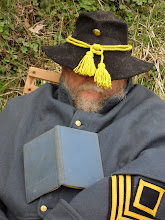The thing that really hits you about the desert is the silence. It's not just quiet, sometimes, when there's no wind or flies, sound hasn't been invented yet. This affects people in different ways. Some try to be as quiet as possible. As if the least sound they make is deafening and may lead some doom down upon them. Others go the other direction. They try to fill up the silence all by themselves. They sing, talk, and make music much louder than is their wont when in civilization (or what passes for such). They seem to fear that the silence will suck away the sounds, so they must supply a surplus to even it out.
The desert blasts not only objects, but people also. It sometimes seems that anyone who lives alone long enough in the high desert ends up either a saint or a mass murderer.
For the writer, the desert is always there waiting. It would be terrible to waste it.
Review (Note to FTC: I bought this dang book myself!)
Buck Fever: The Deer Hunting Tradition in Pennsylvania. Mike Sajna. Pittsburgh: University of Pittsburgh Press, 1990.
Late November is special to me. Three major events in my life collide at that point in this month: my birthday, Thanksgiving, and deer season west of Blue Ridge. The week of Thanksgiving meant I would get to miss school for a week, much to the shared relief of both student and teachers (back before school administrators were under the impression that children belonged to them, it was sufficient that my mom sent in a note saying I wouldn't be in school the next week). Season opened in Virginia's Rockbridge and Augusta Counties the Saturday morning before Thanksgiving. So my daddy and I loaded the truck when he got home Friday afternoon and, after dinner with my mom, the two of us would head southwest. We'd get to the camp about 22:00 [10:00 pm] and be unloaded and in bed by 23:30 [11:30 am]. Ah, to sleep (like that was going to happen with deer season opening at daybreak). During the rest of the dark hours, the rest of the family, in-laws, and outlaws straggled into camp making sure to be in time for breakfast. Then, gray in the eastern sky, we headed for our spots on the mountain where we'd take that six, eight, or--can it be?--the thirty point buck.
Mike Sajna writes about one deer season at his family's deer camp in Warren County on Pennsylvania's Allegheny High Plateau. We meet the various members of his own platoon of the "pumpkin army." The hunters depicted are recognizable to everyone who has hunted with good hunters as opposed to the game hogs, drunks, and hunting slobs one hears about all too often. The Yoopers they ain't.
The reader also learns that deer hunting was destroyed in Pennsylvania by market hunting in the 19th century. How a group of hunters got together and started the state's first conservation organization, the Pennsylvania State Sportsmen's Association, which led in turn to the Pennsylvania Game Commission in 1895. Sajna tells of John MacFarlane Phillips who, horrified at the thought that he had killed the last deer in the state, set out to put the matter right. And put the matter right he did. Through his and his fellow hunters efforts, deer were successfully reintroduced to the state's woods. Upon his death at 92 in 1953, The Pittsburgh Sun-Telegraph called him the "Grand Old Man of Conservation."
Best, Sajna limns the relationship between he and his father as hunters, men, and father and son.
Buck Fever is not a book only for hunters; it will show the non-hunter what goes on in and around a proper deer camp. This is a book that works on many levels as Sajna blends the several interrelated story lines in such a way that each compliments the others and builds a strong and enjoyable whole.
24 November 2009: Feast of St. Andrew Dung-Lac & companions, publication of Charles Darwin's On the Origin of Species 1859, my birthday (you win some, you lose some).




is today your bday? the 24 nov
ReplyDelete